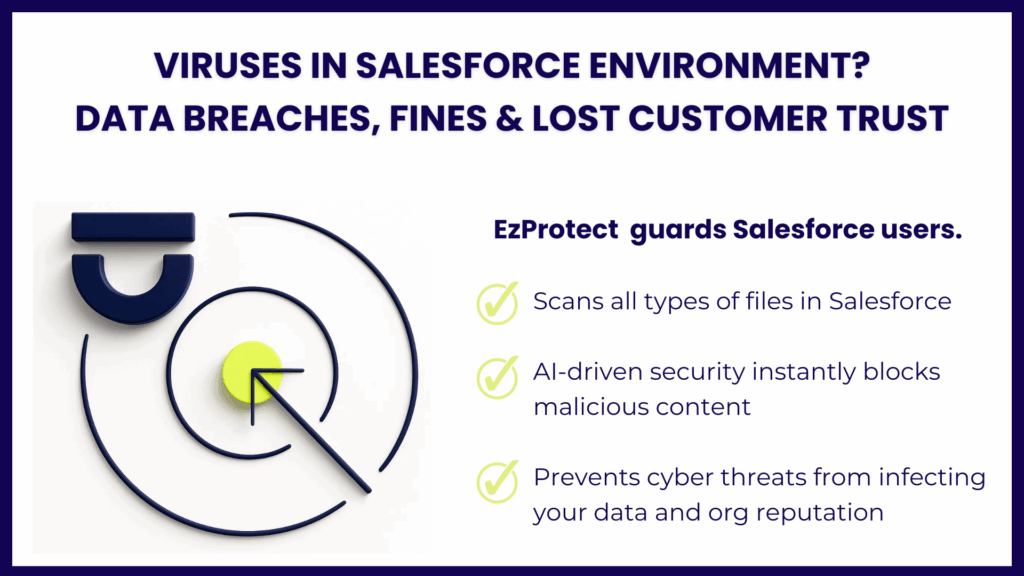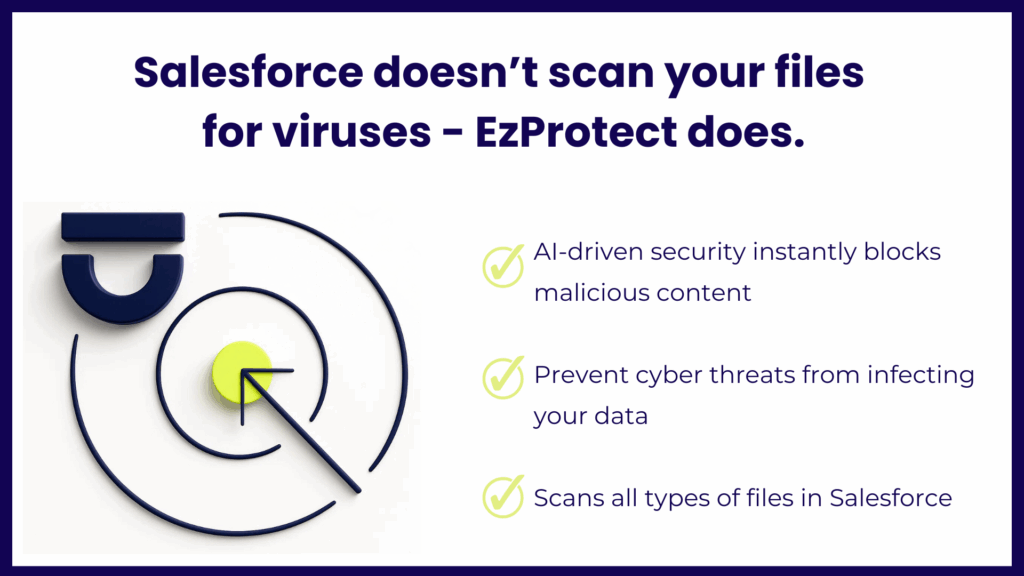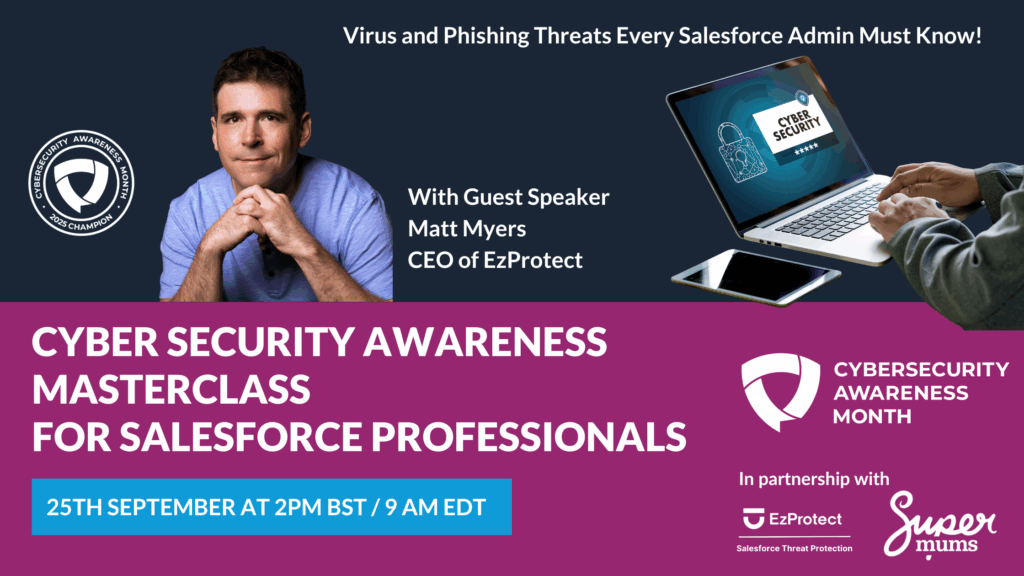The Hidden Cyber Threats Targeting Salesforce
By Heather Black

In this blog we talk about the Cyber Threats targeting Salesforce that every Salesforce Professional Must Know
We want to help Salesforce professionals be aware of cyber threats targeting Salesforce and help you prepare for Cyber Security Awareness Month..
We want you to be aware of the risks, secure your systems and educate your users about cybersecurity threats on your systems.
Don’t worry we are here as a Cyber Awareness Champion to get you ready with a suite of blogs and a live Masterclass.
Check out the live Masterclass taking place this week!
Setting the Scene – How to detect Cyber Threats targeting Salesforce?
It’s Tuesday morning, 8:30 AM. You’re settling into your office chair with your coffee, doing what every Salesforce admin does — checking overnight activity in your org. The weekend was busy as usual, with your sales team uploading new contracts, support agents adding case attachments, and marketing uploading fresh campaign assets. Everything looks perfectly normal in the setup audit trail.
But then you notice something odd. System performance seems sluggish, and a few users have mentioned slower load times. You shrug it off — probably just Monday morning traffic. By Thursday, however, your IT security team is calling an emergency meeting. The news hits you like a freight train: malware has been discovered spreading through your Salesforce environment, and the attack vector was that seemingly innocent contract PDF uploaded by your sales director three days ago.
This scenario represents just one of many attack vectors that Salesforce admins face daily, and it’s particularly concerning for organizations using Salesforce Digital Experiences, which make them extra susceptible to viruses through public-facing file uploads. With cybercriminals increasingly targeting Salesforce environments through malicious file uploads, phishing attacks that surged by 58.2% in 2023, and even ransomware that can encrypt data directly within your instance, the security landscape has never been more dangerous.
This blog explores how to secure your Salesforce digital experiences and the critical security gaps that admins need to know about to protect their organizations from these evolving threats.
How many Cyber Threats target Salesforce?
The scenario above isn’t hypothetical — it’s happening to organizations worldwide as cybercriminals increasingly target Salesforce environments. Attackers know that Salesforce users routinely upload files as part of their daily workflows, from customer contracts and proposals to support case attachments and marketing materials. Each upload represents a potential entry point for malicious content that can compromise entire organizational networks.
The attack methodology has become frighteningly sophisticated. Cybercriminals send carefully crafted phishing emails to Salesforce users containing malicious attachments or links to high-risk file downloads that appear legitimate, mimicking trusted sources or internal communications. Users then download files containing dangerous payloads such as executables or scripts designed to exploit system vulnerabilities or compromise Salesforce credentials through keylogging, credential harvesting, or session hijacking.
Once attackers gain initial access through these infected files, they systematically escalate privileges within the Salesforce environment, accessing sensitive data, manipulating critical records, or obtaining administrative access. They then steal customer records, financial information, and proprietary documents, often using Salesforce’s own features to export data while avoiding detection. This methodical approach ensures maximum data theft while minimizing the likelihood of immediate discovery. The transition from initial file upload to complete organizational compromise can occur within hours, leaving little time for detection and response.
Salesforce is Secure…Until You Start Configuring It
Salesforce has built an impressive reputation for security and customer trust, implementing robust infrastructure protections and compliance measures that meet the highest industry standards. The platform’s security architecture provides excellent protection at the infrastructure level, with advanced monitoring, encryption, and access controls that rival any enterprise platform. However, this foundational security begins to erode the moment organizations start configuring their instances to meet specific business requirements.
The challenge lies in the gap between Salesforce’s infrastructure security and the application-level threats that target configured environments. While Salesforce protects against infrastructure attacks and provides tools for managing user access, it does not scan uploaded files for malware or provide comprehensive threat detection for content that users introduce to the platform. This represents a fundamental security gap that becomes more pronounced as organizations customize their Salesforce environments and integrate with external systems.
Custom configurations, third-party integrations, and user-uploaded content create attack surfaces that Salesforce’s native security features cannot adequately address. Each customization, from custom objects and fields to complex workflows and integrations, potentially introduces new vulnerabilities that require specialized security measures to protect effectively. The misconception that Salesforce’s platform security extends to comprehensive threat detection has left countless organizations exposed to attacks that specifically target these configuration-level vulnerabilities.
The Alarming Rise in Salesforce – Targeted Breaches
Recent months have witnessed an unprecedented surge in sophisticated attacks specifically targeting Salesforce customers, with threat actors developing specialized techniques for compromising Salesforce environments and extracting valuable customer data. These attacks demonstrate a clear pattern of cybercriminals recognizing Salesforce as a high-value target containing concentrated customer information, financial data, and proprietary business intelligence.
The Scattered Spider group’s attack on Qantas exposed 5.7 million customers’ data through a third-party platform used by their contact center, affecting customers with varying levels of data exposure from basic contact information to detailed personal preferences. ShinyHunters’ campaign against Allianz Life demonstrated how social engineering techniques can compromise cloud-based CRM systems, potentially affecting over 700,000 customer records and highlighting the vulnerability of organizations that rely on generic security measures.
The coordinated retail sector attacks targeting Harrods, Co-op, and Marks & Spencer revealed how threat actors are developing industry-specific attack strategies, with M&S alone facing $400 million in costs and 15 weeks of service disruption. The luxury brand attacks on Chanel and Pandora showed that no industry segment remains immune, as attackers used voice phishing techniques to trick employees into handing over credentials or installing malicious applications.
These incidents share disturbing commonalities: they targeted organizations with sophisticated IT departments, affected millions of customer records, and succeeded despite existing security measures. The attacks demonstrate that traditional security approaches fail to protect against threats specifically designed to exploit Salesforce environments, and the financial and reputational consequences continue to escalate as attackers become more sophisticated. Moreover, the emergence of ransomware attacks within Salesforce instances themselves represents a new frontier of risk that many organizations haven’t adequately prepared for, where attackers can encrypt critical business data directly within the platform that organizations depend on for daily operations.
Why Traditional Security Approaches Fail in Salesforce
Generic security providers consistently fail to protect Salesforce environments because they lack the specialized platform knowledge necessary to understand unique attack vectors and security requirements. A recent analysis revealed 298 active threats in a customer’s Salesforce environment that went undetected by their previous generic security solution — they had chosen a general contractor when they needed a specialized engineer.
Traditional security companies focus primarily on protecting desktops and servers, not cloud-based CRM platforms like Salesforce. This fundamental misalignment means they consistently miss critical security gaps specific to Salesforce, such as misconfigured permissions, exposed data through Flows, malicious Apex code, and the unique ways that content moves through Salesforce environments. Relying on traditional security vendors to protect Salesforce is like asking your email spam filter to secure your CRM — it’s simply built for a different purpose.
File extension detection, which identifies files by examining extensions like .exe or .png, represents the most basic and easily defeated security measure that most competitors rely upon. Attackers routinely manipulate file extensions, disguising malicious executables as harmless images or documents, allowing dangerous files to bypass security systems that trust extensions alone. Similarly, MIME-type detection relies on server-provided file type information that attackers easily manipulate by configuring fake servers to send false MIME types.
The most concerning aspect of traditional approaches is how they handle scanning failures. Files over 52 MB cause errors in standard scanners, creating perfect hiding spots for malware, and when competitors encounter these errors, they simply allow the files through unscanned rather than blocking them pending successful verification. This represents a fundamental security failure where the inability to process a file results in defaulting to permissive access rather than protective blocking. Advanced AI-powered scanning solutions address these limitations by implementing true file type detection that examines actual file content regardless of extensions or claimed types, providing the comprehensive analysis necessary to identify sophisticated threats.
Salesforce Doesn’t Scan Your Files for Viruses. EzProtect Does.
EzProtect delivers real-time, AI-powered virus scanning to detect and block cyber threats before they infiltrate your org. This comprehensive security solution prevents malware, phishing, and ransomware attacks with seamless integration across your entire Salesforce environment, providing the specialized protection that Salesforce’s native features cannot deliver.
Unlike generic security tools that simply attach basic virus scanning to Salesforce, EzProtect was built by Salesforce security engineers who understand the platform’s unique architecture and implement a proactive, multi-layered, zero-trust approach to keeping your data secure. With over 50 years of combined Salesforce security and architecture expertise, EzProtect’s team includes a CEO and Co-Founder, Matt Meyers who is a Certified Technical Architect (CTA) and author of the #1 Amazon bestseller “Securing Salesforce Digital Experiences.”


EzProtect’s advanced AI security technology protects Salesforce environments through signature scanning for initial threat screening, heuristic analysis that identifies potentially malicious behavior beyond simple signatures, dynamic sandbox execution that safely runs suspicious files to observe their behavior, and comprehensive file type verification that examines actual content regardless of extensions. This multi-layered approach has proven its effectiveness by uncovering threats that competitors miss, including the 298 active threats discovered in a customer’s environment that their previous security solution completely failed to detect.
The solution provides complete protection for files up to Salesforce’s full 2GB limit, comprehensive URL scanning across unlimited fields and objects, protection for outbound Salesforce emails, and 24/7 expert incident response support. This comprehensive approach ensures that identified threats are swiftly contained and that organizations receive step-by-step assistance through the entire incident management process, from initial detection through post-incident analysis. The focus on Salesforce-specific security challenges, combined with advanced AI-powered detection capabilities, provides the specialized protection that generic security solutions cannot match.
Your Defense Strategy: Taking Action Now on Cyber Threats Targeting Salesforce
The evidence is clear: waiting for organizational approval while threats actively target your Salesforce environment puts your organization at unnecessary risk. Advanced AI-powered scanning solutions represent the only effective defense against sophisticated attacks that specifically target Salesforce configurations and user behaviors. These solutions must provide comprehensive file analysis, real-time threat detection, and specialized understanding of Salesforce architecture to effectively protect against the evolving threat landscape.
Implementing proper security measures requires moving beyond basic extension checking to content-based analysis that can identify the true nature of uploaded files regardless of how attackers attempt to disguise them. This includes protection against ransomware attacks that can encrypt critical business data directly within your Salesforce instance, turning your most valuable business tool into a liability overnight.
The recent breaches affecting Qantas, Allianz Life, M&S, Chanel, and Pandora demonstrate that no organization is too large, too established, or too security-conscious to fall victim to attacks targeting Salesforce environments. These incidents resulted from attack vectors that proper security measures could have prevented, and the financial and reputational consequences continue to mount for organizations that chose inadequate protection.
Don’t let your Salesforce environment become the next multi-million dollar security failure that could have been prevented with proper protection. The sophisticated threat actors targeting Salesforce environments aren’t waiting for your organization to implement adequate security measures — they’re actively probing for vulnerabilities and preparing to strike when they find the right opportunity.
EzProtect offers more than just security scanning — we provide Salesforce Security Office Hours where you can get direct access to our certified security specialists, comprehensive free security resources to keep your team educated about the latest threats, and thorough org assessments that require no org access to ensure you have a complete protection plan in place.
Contact EzProtect today for your complimentary security assessment and discover what threats might already be lurking in your environment before they cause irreversible damage to your organization’s reputation, customer relationships, and bottom line.
Join the Cyber Security Masterclass for Salesforce Professionals

In this interactive session with the Supermums community, Matt Meyers, Salesforce CTA and CEO & Co-Founder of EzProtect, deep dives into how viruses and phishing attacks can impact your customer data, what strategies you can deploy to stop attackers from stealing your data, and takes all of your burning security questions live.
We’ll examine the latest attack vectors targeting Salesforce users, from sophisticated email phishing campaigns to malicious file uploads, and explore practical defense strategies including user education techniques, technical controls within Salesforce, and monitoring approaches that help detect threats before they cause damage.
This session will equip Salesforce professionals with the knowledge to recognize, prevent, and respond to virus and phishing threats that specifically target Salesforce environments.
Join us on Thursday 25th September at 2pm BST / 9am EDT virtually.
If you can’t make it live, register to get the replay.
Matt is a Salesforce CTA, CEO, and CoFounder of EzProtect, a virus-scanning solution for Salesforce.
With 18 years in the Salesforce ecosystem, he’s also the author of the Amazon bestseller “Securing Salesforce Digital Experiences”.
Matt is passionate about well-architected, secure Salesforce implementations and developing the next generation of Salesforce architects.

Written By:
Subscribe To Our Weekly Top Tip Bulletin
Get Updates And Learn From The Best













